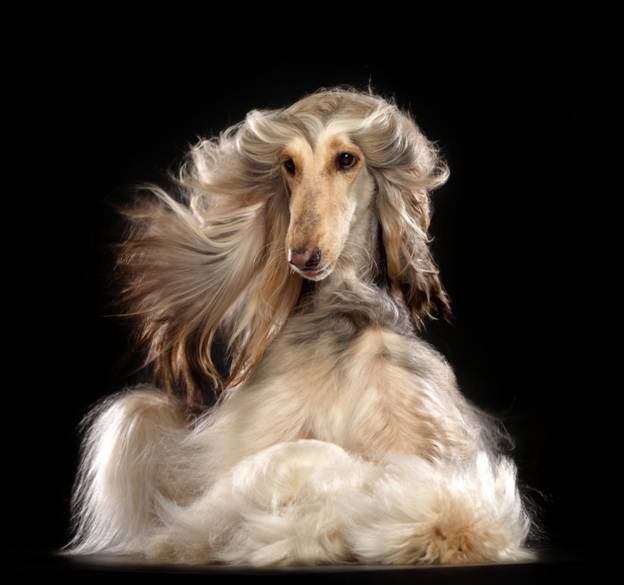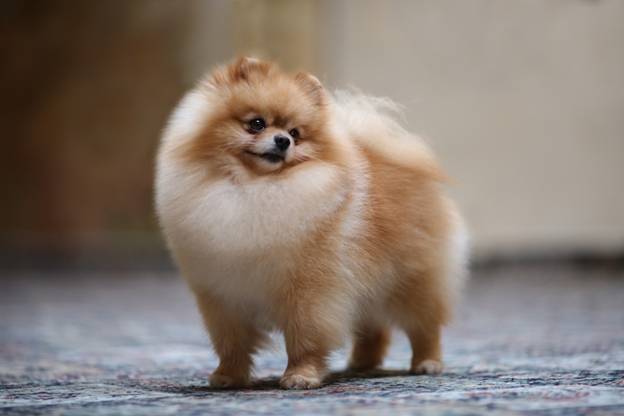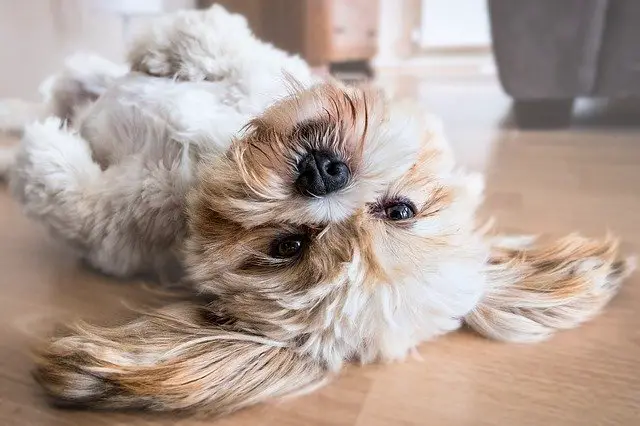If anyone were to know about how to get a dog’s hair to grow back, it’s me.
Hi! My name is Bella, and I’m a shih tzu. As you probably already know, my breed is known for our layered, forever-growing coat. Unless your dog is a shih tzu, it is unlikely that their hair will look like mine, but there are ways to help ensure that your dog’s hair grows to be as long and as lush as possible.
Whether your dog is shedding his coat for the summer or actually has a condition that causes hair loss – such as sarcoptic mange or demodectic mange – there are things you can do to take care of his beautiful hair and get it to grow back.
Today, I’ll give you tips on not only how to get a dog’s hair to grow back and tell you how to maintain the look and feel of the hair he has so that he can stay looking great all year round.
Reasons a Dog’s Hair Falls Out
Maybe you want to know how to get your dog’s hair to grow back because you just took him for a haircut and don’t like the outcome. Trust me, I’ve been there. If this is the case, then all you have to do is be patient and take proper care of your dog.
However, if your dog’s shedding more than usual or has a lot of hair falling out, it is important to determine the root cause before proceeding to change anything, as it could be a sign of a much bigger issue. Bring your pup to the vet right away so that they can determine why your dog’s hair is falling out.
Here are some common reasons that your dog’s hair might be falling out:
Health Problems
Bald spots and excessive shedding could signal significant health issues for us canines. The earlier you can spot these issues, the better chance you’ll be able to treat the condition and get your dog back in good health.
Take your dog to the vet so that they can determine the cause of your dog’s hair loss. They will most likely run a few blood tests or do a biopsy in order to rule out serious conditions. This can be a scary visit for us, so make sure that you calm your dog before, throughout, and after the process.
Some serious conditions that your vet will hopefully rule out include:
- Mange: An aforementioned skin condition that can be caused by a mite, such as mange mites. It’s very itchy!
- Ringworm: A fungal infection that you’ll usually see as a circular area of hair loss, such as a bald spot. At least it’s not itchy.
- Cushing’s disease: A hormonal imbalance that causes us to be hungrier, thirstier, and more tired than usual.
- Bacterial infections: These can include a staph infection.
- Hypothyroidism: This is when our thyroid does not produce enough metabolism-regulating hormones.
Fleas and Ticks

Everyone probably knows, but it bears repeating: We hate fleas! The flea and the tick are major nuisances for us. Either one can trigger an allergic reaction in our skin, which in return may lead to hair loss. Even if there’s no allergic reaction, fleas and ticks are very itchy, making us scratch. This may also lead us to pulling out our own hair, if it doesn’t just fall out from all the scratching due to skin irritation. Fleas and ticks are the worst, and I’m getting itchy just thinking about them!
Allergies
Yes, us dogs get allergies the same way you humans do, except our allergies can cause hair loss. Our allergies can be seasonal and triggered by pollen, or they can be caused by an encounter with a chemical that our nose or skin really doesn’t like.
Here’s a tip: If you recently switched up your dog’s diet and then you notice that your dog’s fur begins to thin and fall out, the new diet may be causing an allergic reaction that triggers your dog’s hair loss. Try changing back to the old diet to see if the hair loss stops.
Pressure Sores
Pressure sores, or bed sores, are injuries that happen when a dog lies in one place for too long.
The friction between hard surfaces and your dog’s body will cause hair loss, and sometimes bleeding, in the specific area affected. Pressure sores are most common in older dogs because their skin is so sensitive.
Stress
Ah, stress. I hear that it’s a big reason for hair loss in humans. Well, guess what, us dogs can lose our hair because of stress too!
Our stress can be triggered by staying alone for too long, like when you go off to work in the morning. It can also be triggered by an unfamiliar environment that includes new noises, sounds, lights, and people. Even if we move to a new house with our owners, we can still get stressed out because of the unfamiliarity with our environment.
If you have recently moved into a noisy neighborhood or anywhere that is unfamiliar to your dog, this could be the reason that he is stressed out. Try to keep your dog’s stress away by spending as much time with him as possible and taking him for some daily exercise.
Tips for Growing Your Dog’s Hair Back

Depending on the cause of the hair loss, your dog’s hair is likely to grow back. Nonetheless, it doesn’t hurt to help him out a bit to make sure that your dog’s coat grows back quickly and as lush as before.
Here are some tips on how to get a dog’s hair to grow back.
Keep up a Good Diet
Great hair starts from within. I think the same goes for you humans!
If you want your dog’s hair to be strong, shiny, and healthy, make sure you provide him with a nutritious diet. Try to create a feeding regimen for your dog that consists of good-quality, nutrient-rich foods. To do this, you have to buy your pup good-quality dog food.
When buying dog food for your best friend, make sure that you pay close attention to the ingredients. Stay away from unnatural or artificial ingredients, or foods that are packed with sugar.
If you can, feed your dog foods that are rich in Omega-3 and Omega-6 fatty acids. You can use supplements, but they are most effective when given fresh. These fatty acids are good for dog hair and have other great benefits for your dog, like fighting different types of infections, boosting their mood, and easing any pain they may feel from arthritis or other joint issues.
Even though we love junk food, it’s also a good idea to give your dog some healthy treats. Veggies are definitely not my favorite, but even I can recognize that carrots are healthy and good for my coat and teeth.
If you want, you can add a teaspoon of a plant-based oil, such as vegetable oil, to your dog’s food bowl to give his hair some extra glow. A dog that is healthy on the inside radiates health through his coat.
Give Your Dog Supplements
Even though we should be getting most of our nutrients from fresh food, herbal supplements can help a dog’s hair grow back faster. Not only that, but some supplements can soften your dog’s hair and improve the health of his skin. Do some research on the benefits of different supplements on dogs, but if you don’t know where to start, I hear that horsetail and spirulina are really good for a dog’s coat.
Make sure you don’t go overboard with the doses of certain supplements, as it could upset our stomachs and make us sick. Make sure you consult the vet on recommended dosage before giving your dog any supplements.
Brushing
No matter what type of hair or fur your dog has, you should aim to brush him every day, if not every couple of days. Brush from the skin up to get rid of any dead hair and promote new skin cell production, which will result in more hair growth.
It’s important to use the right brush on your dog. There’s a brush out there for every dog breed, so find one that suits your dog’s hair and make time for a good brush session. My owner uses this slicker brush on my hair. It’s big enough to make brushing my long coat a lot easier! If your dog tends to shed a lot, you may also want to get a deshedding brush to keep it under control.
Here’s a tip: putting a little bit of oil in our food isn’t the only way to make our hair look shiny. You can also use oil directly on our hair. Olive is a great oil to use to moisturize our skin and distribute in our hair. It not only makes it soft, but it also adds shine. Massage a little bit on your dog’s hair before you begin brushing, then brush as per usual to evenly distribute the oil. You can also add a few drops of oil to our shampoo to get some shine when we dry.
Use Oatmeal Shampoo
Depending on your furry friend’s breed and how much time they spend indoors, you should give him a bath anywhere from once a week to once a month. However, be careful not to bathe your dog too often. Too many baths can damage our coat and impede hair growth by stripping away the natural oils our skin needs.
To make the most out of bath time, use an oatmeal shampoo. Oatmeal shampoos are specially made for our skin and coat, and they’re effective at removing the first bacteria that stops our hair from growing. My owner uses this oatmeal shampoo to bathe me, and I love it because it soothes my skin, which really helps me cope with my pollen allergy in the summer.
To kill any other growth-hindering bacteria on your dog’s skin, you can also try spraying him with a mixture of a small amount of apple cider vinegar diluted in a large amount of water after each bath.
Take Your Dog to the Vet
I usually think the veterinarian is the worst, but I will admit that sometimes they give good advice for humans taking care of us dogs.
If you notice drastic changes in your dog’s hair, such as dryness, more shedding than usual, or complete hair loss, take him to the vet to make sure that everything is OK.
Growing Your Dog’s Hair

There you have it! I’ve told you everything you need to know about growing your dog’s hair back. By following these tips, you’ll be able to grow your dog’s coat back to what it was like before, or even better!